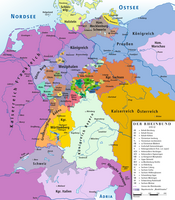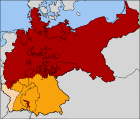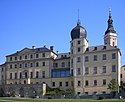Księstwo Reuss (linii starszej)
| 1778–1918 | |||||
| |||||
| Stolica | |||||
|---|---|---|---|---|---|
| Ustrój polityczny | |||||
| Głowa państwa | Książę Henryk XXIV | ||||
| Powierzchnia • całkowita |
| ||||
| Liczba ludności (1905) • całkowita • gęstość zaludnienia |
| ||||
| podniesienie do rangi księstwa | 12 maja 1778 | ||||
| Proklamacja republiki | 11 listopada 1918 | ||||
| Mapa państw Turyngii w ramach Cesarstwa Niemieckiego (1871–1918). Zaznaczone jest Księstwo Reuss. | |||||
Księstwo Reuss, linii starszej, także Księstwo Reuss-Greiz (niem. Fürstentum Reuß-Greiz) – mały kraj Świętego Cesarstwa Rzymskiego, we wschodniej części dzisiejszej Turyngii. Stolicą księstwa był Greiz. W latach 1806–1815 kraj Związku Reńskiego, a od 1815 roku państwo Związku Niemieckiego. Od 1871 roku kraj Cesarstwa Niemieckiego.

Historia
Tereny księstwa wyodrębniły się w 1564 roku, kiedy po śmierci Henryka XIII, jego synowie podzielili swoje państwo na trzy hrabstwa:
- Reuss Dolnego Greiz,
- Reuss Górnego Greiz,
- Reuss-Gera.
Po śmierci Henryka III, hrabiego Greiz, 17 marca 1768 roku doszło do zjednoczenia Górnego i Dolnego Greiz. Zjednoczone hrabstwo było zarządzane przez główną i pierwszą gałąź domu Reuss – stąd określenie linii starszej. 12 maja 1778 roku, za panowania Henryka XI, kraj uzyskał rangę Księstwa Reuss (linii starszej). W 1918 roku obalono monarchię i ustanowiono, łącząc ziemie obydwu dawnych księstw Reuss, Republikę Reuss.
Książęta
- w latach 1743–1800 Henryk XI Reuß-Greiz (1722–1800)
- w latach 1800–1817 Henryk XIII Reuß-Greiz (1747–1817)
- w latach 1817–1836 Henryk XIX Reuß-Greiz (1790–1836)
- w latach 1836–1859 Henryk XX Reuß-Greiz (1794–1859)
- w latach 1859–1867 Karolina von Hessen-Homburg (1819–1872)
- w latach 1867–1902 Henryk XXII Reuß linii starszej (1846–1902)
- w latach 1902–1918 Henryk XXIV Reuß linii starszej 1878–1927), niezdolny do rządzenia. Regenci:
- 1902–1908 Heinrich XIV Reuss linii młodszej (1832–1913)
- 1908–1918 Henryk XXVII Reus linii młodszej, książę, regent i od 1913 r. książę linii młodszej (1858–1928)
Tytularni książęta Reuss-Greiz
- Henryk XXIV (1878–1927), w 1927 włączone do Księstwa Reuss.
Bibliografia
- Ulrich Hess: Geschichte Thüringens 1866 bis 1914. Verlag Hermann Böhlaus Nachfolger, Weimar 1991, ISBN 3-7400-0077-5
- Reinhard Jonscher, Willy Schilling: Kleine thüringische Geschichte. Jenzig-Verlag, 3. Aufl., Jena 2003, ISBN 3-910141-44-7
Zobacz też
Media użyte na tej stronie
Flag of the duchy of Saxe-Coburg & Gotha 1911-1920; Ratio (2:3)
Flag of the Kingdom of Württemberg; Ratio (3:5)
Autor: ziegelbrenner, Licencja: CC BY 2.5
Map of Confederation of the Rhine 1812
Flag of the Grand Duchy of Baden 1855-1891; Ratio (3:5)
Flag of the duchy of Saxe-Coburg & Gotha 1826-1911; Ratio (2:3)
Flag of Alsace-Lorraine, adopted on the 25th of June 1912 and flag of the Republic of Alsace-Lorraine (Nov 11 1918 - Nov 21 1918)
Flag of the Duchy of Anhalt and also flag of Augsburg
Flag of the principality of Reuß Younger Line; Ratio (4:5) may also be (5:6)
Flag of the principality of Lippe; Ratio (2:3)
Flag of the Grand Duchies of Mecklenburg-Strelitz and Mecklenburg-Schwerin; Ratio (2:3)
Autor: User:52 Pickup, Licencja: CC BY-SA 2.5
The North German Confederation / Norddeutscher Bund (1867–1871) in red. The states that would join the confederation and form the German Empire are in orange. Alsace-Lorraine, the territory annexed from France following the Franco-Prussian War of 1871, is in a paler orange.
Heinrich XIII., Reuss Elder Line (Reuß ältere Linie) (1747–1817)
Autor: Michael Sander, Licencja: CC-BY-SA-3.0
Das Untere Schloss in Greiz (Thüringen).
Flaga Niemiec o proporcjach 3:2
Flag of the Grand Duchy of Saxe-Weimar-Eisenach 1813-1897; Ratio (2:3)
Flag of the principalities of Schwarzburg-Sondershausen and Schwarzburg-Rudolstadt; Ratio (2:3)
Flag of the Kingdom of Saxony; Ratio (2:3)
Flag of the Grand Duchy of Hesse without arms; Ratio (4:5)
Civil flag of Oldenburg, before 1871 and beween 1921 and 1935
Flag of the principality of Schaumburg-Lippe; Ratio (2:3), c. 1880–1935
Flag of the duchy of Brunswick; Ratio (2:3)
Autor: Michael Sander, Licencja: CC-BY-SA-3.0
Das Obere Schloss in Greiz (Thüringen).
Imperial Eagle of the German Empire from 1889 to 1918.
Flag of the principality of Reuss Elder Line; Ratio (27:34)
Autor: Glasshouse using elements by Sodacan, Tom-L and Katepanomegas, Licencja: CC BY-SA 4.0
Coat of Arms of the Principality of Reuss-Greiz, Older Line. These arms differ from those of the Principality of Reuss-Greiz, Younger Line, in that the lion supporters are all gold













































